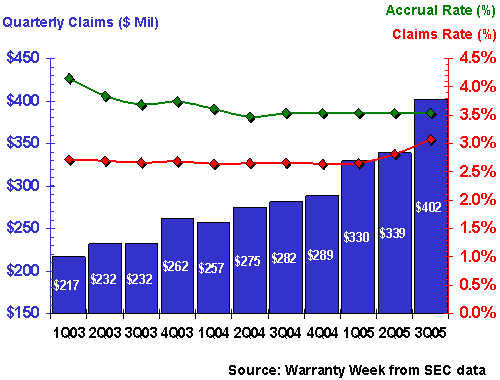Computer Warranties:
It's entirely possible that HP, Dell, and IBM are each now paying roughly the same percentage of their hardware revenue to satisfy warranty claims. A year ago, HP was paying much more, and Dell and IBM were paying less.
Top computer manufacturers based in the U.S. have paid out just under $4 billion in warranty claims during the first three quarters of 2005, equivalent to around 3.2% of their total computer hardware revenue over the same period, according to statistics compiled by Warranty Week.
We're now well into the third quarter earnings reporting season, and by press time all the major computer vendors except Apple Computer Inc. had filed their latest quarterly financial report with the U.S. Securities and Exchange Commission.
Apple, which closes out its fiscal year at the end of September, is not expected to file its annual report with the SEC until early December. To fill that gap, Warranty Week has inserted placeholding estimates for Apple into the charts that follow. When the actual data becomes available in December, we'll recompute these charts using the new numbers.
Dell Inc. and Hewlett-Packard Co., meanwhile, are on fiscal years that end on Jan. 31 and Oct. 31, respectively. As with other companies not on a strict calendar year schedule, we're transposing their fiscal years based on the calendar quarter in which they end. Therefore, Dell's fourth fiscal quarter is transposed to the first calendar quarter (since it ends in January), and HP's fiscal fourth quarter is mapped to the calendar fourth quarter (since it ends in October).
Increasing Warranty Claims
For each of these computer manufacturers, along with International Business Machines Corp., Sun Microsystems Inc., Gateway Inc., Palm Inc., and several others, we now have at least 33 months of warranty claims and accrual data in hand, stretching back to at least the beginning of 2003. What that data shows is that warranty claims, at $1.36 billion in the third quarter, have never been higher, but are in the middle of the range they have established over the last 11 quarters as a percentage of revenue.
In other words, revenue is rising at more or less the same rate as warranty claims. However, claims have risen rather suddenly and recently at both IBM and Dell, and have fallen significantly at HP, to the point that each of these "big three" may now be paying roughly three-and-a-half percent of their product revenue to honor warranty claims. That's an astonishing change from past patterns.
The following chart shows actual dollars paid by HP, Dell, IBM, Sun, Apple, Palm, and Gateway over the past 11 quarters. The data for HP, Dell, and IBM is labeled, but labels wouldn't fit for Sun (yellow), Apple (orange), Palm (purple), or Gateway (green). Since Apple has yet to report its latest quarter, we've simply repeated the $50 million in claims that they reported for the second calendar quarter. All other data reflects actual reports filed with the SEC through the close of business on Nov. 9, 2005.
Top U.S.-based Computer Manufacturers
Product Warranty Claims
in $ Millions per Quarter
1Q 2003 to 3Q 2005

Source: Warranty Week from SEC data
The total for warranty claims paid per quarter has slowly grown from $1.18 billion in early 2003 to the current $1.36 billion level. Claims had, in fact, grown at an extremely slow rate in both 2003 and 2004. However, they're up considerably in the first three quarters of 2005, as the chart shows. The source of most of these increases has been Dell and IBM, which is clear from the upward slope of their light and dark blue slices. HP's claims total, in red, has actually been contracting significantly of late. In fact, the company paid the least amount of dollars in the quarter that includes the months of May, June, and July 2005 than in any other quarter since reporting began.
Historically, computer manufacturers have accounted for roughly 20% of all warranty claims. So far in 2005, total warranty claims for U.S.-based computer manufacturers during the first nine months of the year stands at $3.98 billion, up 9.3% from the $3.64 billion seen in the first nine months of 2004. With hardware sales reported by these manufacturers estimated at $123 billion for the most recent nine months, the claims rate stands at 3.2% of warranted product sales revenue.
Comparing Claims Rates
HP, IBM, Sun, and Palm are above that industry average rate, while Dell, Apple, and Gateway are below it. It's highly likely that the differences have more to do with what each manufacturer counts as a warranty expense than any meaningful differences in product quality. In other words, Gateway's 1.2% claims rate and IBM's 3.6% claims rate in no way imply that Gateway's computers are somehow three times better than IBM, or are 1/3rd as likely to need repairs. Comparisons between vendors, without making adjustments for internal accounting methodologies, are highly misleading.
One can, however, compare any one vendor against itself over time. One has to assume that if one company counts the cost of replacement parts as a warranty expense and another does not, they each do so consistently over time. Likewise, if one includes the partial cost of operating a call center and another does not, one can only assume that they do so constantly over time, unless there have been disclosures to the contrary. If one were to find out that companies have been lowering their warranty costs simply by removing cost components from their methodologies, well then we're right back to the era of Enron and WorldCom, when their annual reports belonged in the fiction aisle.
Let's start with HP. The company manufactures everything from printers and handheld computers to huge transaction processing systems, so its warranty expenditures reflect quite a few product lines -- each with their own unique failure rate and typical cost of repair. So the overall product warranty claims totals and rates in the chart below are the average of numerous different individual rates.
Hewlett-Packard Co.
Warranty Claims & Accruals
in % of Sales & $m per Quarter
1Q 2003 to 3Q 2005

As was mentioned, HP's most recent quarter saw the lowest claims total of the past 11 quarters -- $566 million, equal to 3.5% of hardware sales revenue. The company's claims rate has been close to that level all year, but has not been lower. The rate was above 4% during 2003 and ranged between 3.6% and 3.8% in 2004, so being able to maintain a 2.5% rate for nine months is quite an improvement.
HP continues to accrue funds to pay future claims (green line) at a slightly higher rate than is shown by current claims (red line), but in reality the two lines are so close that they could be the same. HP's warranty reserve fund balance has increased from $1.96 billion a year ago to $2.11 billion now. Translated into a capacity to pay claims, HP's reserves stood at 10 months' worth a year ago and 11 months' worth now, which means its reserves would last longer now if accruals ceased completely.
Using Estimates for Dell
Dell also has increased its reserves. A year ago, Warranty Week estimated that Dell had $1.85 billion set aside to pay warranty claims, plus a significant amount of deferred revenue accrued from the sale of extended warranties (see the Oct. 25 issue for a detailed analysis). At the end of the most recent quarter, we estimate that Dell had $2.25 billion in its reserve fund, meaning that in the past year Dell's reserves have exceeded HP's for the first time.
Dell's capacity to pay claims, meanwhile, has actually fallen, we estimate, from 20 to 17 months. This means that given the rate at which Dell was paying warranty claims a year ago, its reserves would have lasted 20 months. Now they'd last 17 months. Over the past 11 quarters, the computer industry average has varied from 10 to 13 months.
Dell's claims rate, meanwhile, has risen significantly in recent months. As the chart below details, Dell had paid an unusually constant range of between 2.6% and 2.7% of product revenue on warranty claims for 10 quarters in a row (we assume that 10% of Dell's total revenue is derived from non-warranted sources such as service). Then suddenly in the second quarter of 2005 (corresponding in this case to February, March and April) the rate jumped to 2.8%. In the most recent quarter, the claims rate jumped again, this time to 3.1%.
While that's far below the claims rate turned in by HP, we suspect that once all accounting differences were eliminated, it might no longer be true. For instance, HP publishes figures that detail the percentage of total revenue derived from non-warranted sources such as service (21%). We estimate only 10% for Dell, based on the revenue mix seen at Apple, but Dell's product mix may indeed now be closer to HP's. This would mean we should be subtracting 21% of Dell's overall revenue before computing the claims rate, and that in turn would boost the company's most recent claims rate to 3.5% -- nearly identical to HP's.
Dell Inc.
Warranty Claims & Accruals
in % of Sales & $m per Quarter
1Q 2003 to 3Q 2005

Meanwhile, we also must now estimate Dell's accrual rate, because the company has discontinued providing figures for the amount it accrues to pay future warranty claims. Instead, for the past five quarters it has published only a combined figure for warranty accruals and extended warranty sales. So what we have done is to hold the green line constant at 3.5% -- the last accurate reading we had. If it's changed since then, it's not reflected in the chart above. Instead, the green line appears to be smooth, flat, and exactly horizontal, which of course it is.
Compared to the HP chart, the two lines for Dell have significantly more space between them, with the green line always on top. This means that Dell is always saving more than it is paying, with the result that its reserves are growing. At the same time, extended warranties are being sold at a profit, meaning that Dell is accumulating more cash than it can spend on claims from two separate sources: excess accruals and service plans.
IBM Shows a Sudden Rise
The big surprise of the top three vendors is IBM. While Dell has seen an upturn in claims and HP has seen a downturn, IBM has seen a real jump in claims. As the chart below shows, the company had for eight quarters seen warranty claims remain on a downward slope, from 3.3% in early 2003 to 3.0% in early 2004 and 2.6% for the full year of 2004. But then the trend reversed itself, and the claims rate has risen throughout 2005.
IBM Corp.
Warranty Claims & Accruals
in % of Sales & $m per Quarter
1Q 2003 to 3Q 2005

As the chart shows, IBM's claims rate has now risen to in excess of 3.6% -- the highest it's been since IBM began reporting its warranty expenditures. Because of the divestiture of the PC operations and other factors, IBM's warranted hardware revenues have fallen by 20% over the past year. Claims, meanwhile, grew by 7%, from $590 million during the first nine months of 2004 to $633 million during the first nine months of 2005.
It's not exactly a code red manufacturing crisis, but it is a significant change. Further down the list, companies such as Sun Microsystems and Palm Inc. have grown accustomed to spending 5% or even occasionally 6% of their revenue on warranty claims. In the printer industry, 8% or 9% is typical. So IBM's 3.6% is hardly excessive.
IBM's Claims Rate Higher Than HP's or Dell's?
But consider this: IBM now has a higher claims rate than either HP or Dell, and it no longer manufactures the laptops that even Lenovo has admitted suffered from elevated rates of warranty claims. Even if we were to adjust Dell's warranted-to-not warranted revenue ratio to equal HP's, IBM's 3.6% claims rate would still be higher than either Dell's or HP's.
Again, one cannot compare one company's claims rate against another's, but one can compare one company against itself. At HP, the trend is downward, while at Dell and IBM the trend is upward. It's now gotten to the point where an external observer would need to know intricate details about what is and isn't considered a warranty expense at each of these companies in order to answer the question of which has the highest warranty claims rate.
| Go to Part Two |








